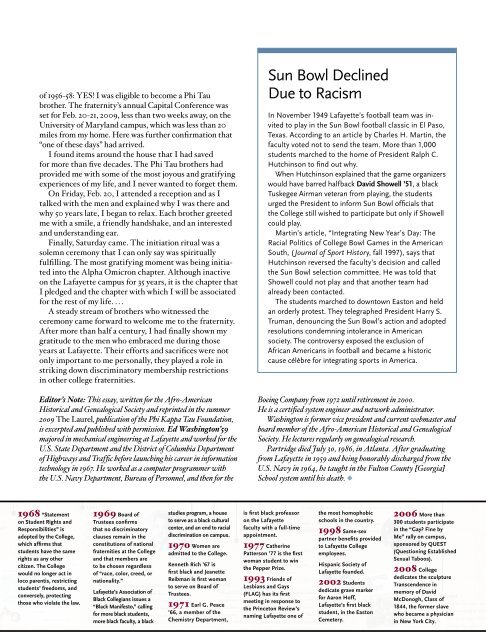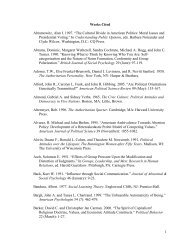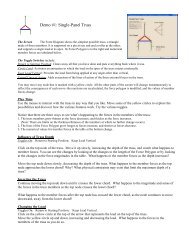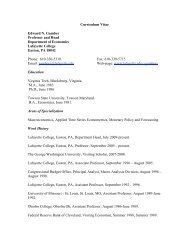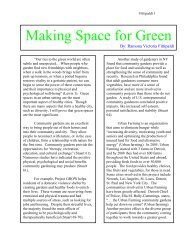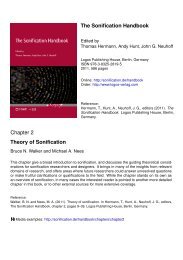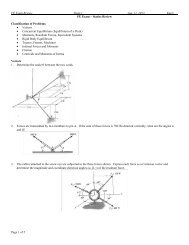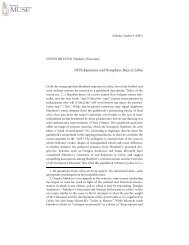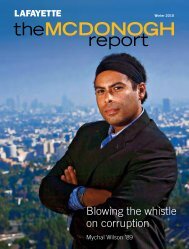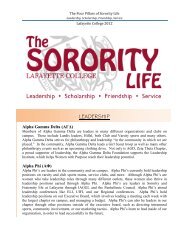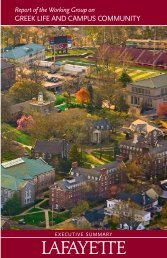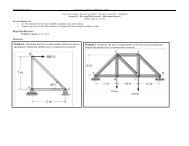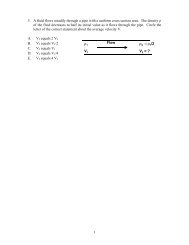2011 - Sites at Lafayette - Lafayette College
2011 - Sites at Lafayette - Lafayette College
2011 - Sites at Lafayette - Lafayette College
You also want an ePaper? Increase the reach of your titles
YUMPU automatically turns print PDFs into web optimized ePapers that Google loves.
of 1956-58: YES! I was eligible to become a Phi Tau<br />
brother. The fr<strong>at</strong>ernity’s annual Capital Conference was<br />
set for Feb. 20-21, 2009, less than two weeks away, on the<br />
University of Maryland campus, which was less than 20<br />
miles from my home. Here was further confirm<strong>at</strong>ion th<strong>at</strong><br />
“one of these days” had arrived.<br />
I found items around the house th<strong>at</strong> I had saved<br />
for more than five decades. The Phi Tau brothers had<br />
provided me with some of the most joyous and gr<strong>at</strong>ifying<br />
experiences of my life, and I never wanted to forget them.<br />
On Friday, Feb. 20, I <strong>at</strong>tended a reception and as I<br />
talked with the men and explained why I was there and<br />
why 50 years l<strong>at</strong>e, I began to relax. Each brother greeted<br />
me with a smile, a friendly handshake, and an interested<br />
and understanding ear.<br />
Finally, S<strong>at</strong>urday came. The initi<strong>at</strong>ion ritual was a<br />
solemn ceremony th<strong>at</strong> I can only say was spiritually<br />
fulfilling. The most gr<strong>at</strong>ifying moment was being initi<strong>at</strong>ed<br />
into the Alpha Omicron chapter. Although inactive<br />
on the <strong>Lafayette</strong> campus for 35 years, it is the chapter th<strong>at</strong><br />
I pledged and the chapter with which I will be associ<strong>at</strong>ed<br />
for the rest of my life. . . .<br />
A steady stream of brothers who witnessed the<br />
ceremony came forward to welcome me to the fr<strong>at</strong>ernity.<br />
After more than half a century, I had finally shown my<br />
gr<strong>at</strong>itude to the men who embraced me during those<br />
years <strong>at</strong> <strong>Lafayette</strong>. Their efforts and sacrifices were not<br />
only important to me personally, they played a role in<br />
striking down discrimin<strong>at</strong>ory membership restrictions<br />
in other college fr<strong>at</strong>ernities.<br />
Editor’s Note: This essay, written for the Afro-American<br />
Historical and Genealogical Society and reprinted in the summer<br />
2009 The Laurel, public<strong>at</strong>ion of the Phi Kappa Tau Found<strong>at</strong>ion,<br />
is excerpted and published with permission. Ed Washington’59<br />
majored in mechanical engineering <strong>at</strong> <strong>Lafayette</strong> and worked for the<br />
U.S. St<strong>at</strong>e Department and the District of Columbia Department<br />
of Highways and Traffic before launching his career in inform<strong>at</strong>ion<br />
technology in 1967. He worked as a computer programmer with<br />
the U.S. Navy Department, Bureau of Personnel, and then for the<br />
Sun Bowl Declined<br />
Due to Racism<br />
In November 1949 <strong>Lafayette</strong>’s football team was invited<br />
to play in the Sun Bowl football classic in El Paso,<br />
Texas. According to an article by Charles H. Martin, the<br />
faculty voted not to send the team. More than 1,000<br />
students marched to the home of President Ralph C.<br />
Hutchinson to find out why.<br />
When Hutchinson explained th<strong>at</strong> the game organizers<br />
would have barred halfback David Showell ’51, a black<br />
Tuskegee Airman veteran from playing, the students<br />
urged the President to inform Sun Bowl officials th<strong>at</strong><br />
the <strong>College</strong> still wished to particip<strong>at</strong>e but only if Showell<br />
could play.<br />
Martin’s article, “Integr<strong>at</strong>ing New Year’s Day: The<br />
Racial Politics of <strong>College</strong> Bowl Games in the American<br />
South, (Journal of Sport History, fall 1997), says th<strong>at</strong><br />
Hutchinson reversed the faculty’s decision and called<br />
the Sun Bowl selection committee. He was told th<strong>at</strong><br />
Showell could not play and th<strong>at</strong> another team had<br />
already been contacted.<br />
The students marched to downtown Easton and held<br />
an orderly protest. They telegraphed President Harry S.<br />
Truman, denouncing the Sun Bowl’s action and adopted<br />
resolutions condemning intolerance in American<br />
society. The controversy exposed the exclusion of<br />
African Americans in football and became a historic<br />
cause célèbre for integr<strong>at</strong>ing sports in America.<br />
Boeing Company from 1972 until retirement in 2000.<br />
He is a certified system engineer and network administr<strong>at</strong>or.<br />
Washington is former vice president and current webmaster and<br />
board member of the Afro-American Historical and Genealogical<br />
Society. He lectures regularly on genealogical research.<br />
Partridge died July 30, 1986, in Atlanta. After gradu<strong>at</strong>ing<br />
from <strong>Lafayette</strong> in 1959 and being honorably discharged from the<br />
U.S. Navy in 1964, he taught in the Fulton County [Georgia]<br />
School system until his de<strong>at</strong>h. ◆<br />
1968 “St<strong>at</strong>ement<br />
on Student Rights and<br />
Responsibilities” is<br />
adopted by the <strong>College</strong>,<br />
which affirms th<strong>at</strong><br />
students have the same<br />
rights as any other<br />
citizen. The <strong>College</strong><br />
would no longer act in<br />
loco parentis, restricting<br />
students’ freedoms, and<br />
conversely, protecting<br />
those who viol<strong>at</strong>e the law.<br />
1969 Board of<br />
Trustees confirms<br />
th<strong>at</strong> no discrimin<strong>at</strong>ory<br />
clauses remain in the<br />
constitutions of n<strong>at</strong>ional<br />
fr<strong>at</strong>ernities <strong>at</strong> the <strong>College</strong><br />
and th<strong>at</strong> members are<br />
to be chosen regardless<br />
of “race, color, creed, or<br />
n<strong>at</strong>ionality.”<br />
<strong>Lafayette</strong>’s Associ<strong>at</strong>ion of<br />
Black Collegians issues a<br />
“Black Manifesto,” calling<br />
10 ◆ McDonogh report for more ◆ black<br />
Winter<br />
students,<br />
<strong>2011</strong><br />
more black faculty, a black<br />
studies program, a house<br />
to serve as a black cultural<br />
center, and an end to racial<br />
discrimin<strong>at</strong>ion on campus.<br />
1970 Women are<br />
admitted to the <strong>College</strong>.<br />
Kenneth Rich ’67 is<br />
first black and Jeanette<br />
Reibman is first woman<br />
to serve on Board of<br />
Trustees.<br />
1971 Earl G. Peace<br />
’66, a member of the<br />
Chemistry Department,<br />
is first black professor<br />
on the <strong>Lafayette</strong><br />
faculty with a full-time<br />
appointment.<br />
1977 C<strong>at</strong>herine<br />
P<strong>at</strong>terson ’77 is the first<br />
woman student to win<br />
the Pepper Prize.<br />
1993 Friends of<br />
Lesbians and Gays<br />
(FLAG) has its first<br />
meeting in response to<br />
the Princeton Review’s<br />
naming <strong>Lafayette</strong> one of<br />
the most homophobic<br />
schools in the country.<br />
1998 Same-sex<br />
partner benefits provided<br />
to <strong>Lafayette</strong> <strong>College</strong><br />
employees.<br />
Hispanic Society of<br />
<strong>Lafayette</strong> founded.<br />
2002 Students<br />
dedic<strong>at</strong>e grave marker<br />
for Aaron Hoff,<br />
<strong>Lafayette</strong>’s first black<br />
student, in the Easton<br />
Cemetery.<br />
2006 More than<br />
300 students particip<strong>at</strong>e<br />
in the “Gay Fine by<br />
Me” rally on campus,<br />
sponsored by QUEST<br />
(Questioning Established<br />
Sexual Taboos).<br />
2008 <strong>College</strong><br />
dedic<strong>at</strong>es the sculpture<br />
Transcendence in<br />
memory of David<br />
McDonogh, Class of<br />
1844, the former slave<br />
who became a physician<br />
in New York City.


